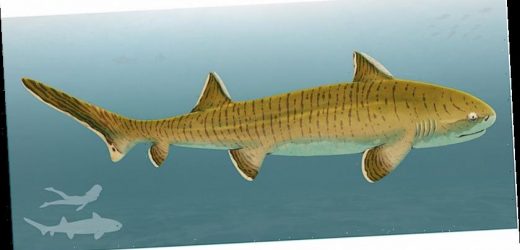Fox Business Flash top headlines for January 18
Fox Business Flash top headlines are here. Check out what’s clicking on FoxBusiness.com.
Experts have discovered an “almost-complete” fossil of a 150-million-year-old shark in Germany, giving them a nearly unprecedented look into Earth’s distant past.
The study, published in the scientific journal Papers in Palaeontology, describes a fossilized Asteracanthus, which lived between 361 million years and 66 million years ago. The fossil was discovered in the Solnhofen limestones in Bavaria, Germany, famous for the discovery of the first archaeopteryx and other shark and ray skeletons.
“The specimen is represented by an almost completely preserved skeleton of the extinct hybodontiform shark Asteracanthus, the total length of which was two-and-a-half meters in life, which made it a giant among Jurassic sharks,” a statement from the University of Vienna reads.
Tentative life reconstruction of the hybodontiform shark Asteracanthus; for scale see silhouettes at the right lower corner (Credit: Sebastian Stumpf/Fabrizio De Rossi).
NEW DETAILS REVEALED ABOUT MEGALODON’S SHOCKING SIZE: THEY ATE THEIR SIBLINGS IN THE WOMB
Asteracanthus was a type of Hybodontiformes, a close relative of modern sharks and rays. Hybodontiformes had two dorsal fins and ranged in size, with some as small as a few centimeters, all the way to nearly 10 feet in length.
While ancient shark teeth have been found all over the world, because they are made of cartilage, fossilized shark skeletons are rare.
The fossil of Asteracanthus contained more than 150 teeth, which all had “a well-developed central cusp that is accompanied on both sides by several smaller cusplets,” the university added.
Almost complete skeleton of the hybodontiform shark Asteracanthus recovered from the Late Jurassic Solenhofen limestones in Bavaria, Germany, including close-up view pictures of its dorsal fin spines and tentative life reconstruction (Credit: Sebastian Stumpf; life reconstruction © Fabrizio De Rossi).
“This specialized type of dentition suggests that Asteracanthus was an active predator feeding on a wide range of prey animals,” study co-author Sebastian Stumpf explained. “Asteracanthus was certainly not only one of the largest cartilaginous fishes of its time, but also one of the most impressive.”
Asteracanthus was first discovered by Swiss-American naturalist Louis Agassiz nearly 180 years ago after looking at “isolated fossil dorsal fin spines,” the university added.
BIZARRE 370M-YEAR-OLD SHARK HAD TEETH UNLIKE ANY OTHER CREATURE ON EARTH
In November, researchers discovered a 370-million-year old shark with bizarre teeth.
CLICK HERE TO GET THE FOX NEWS APP
Source: Read Full Article





